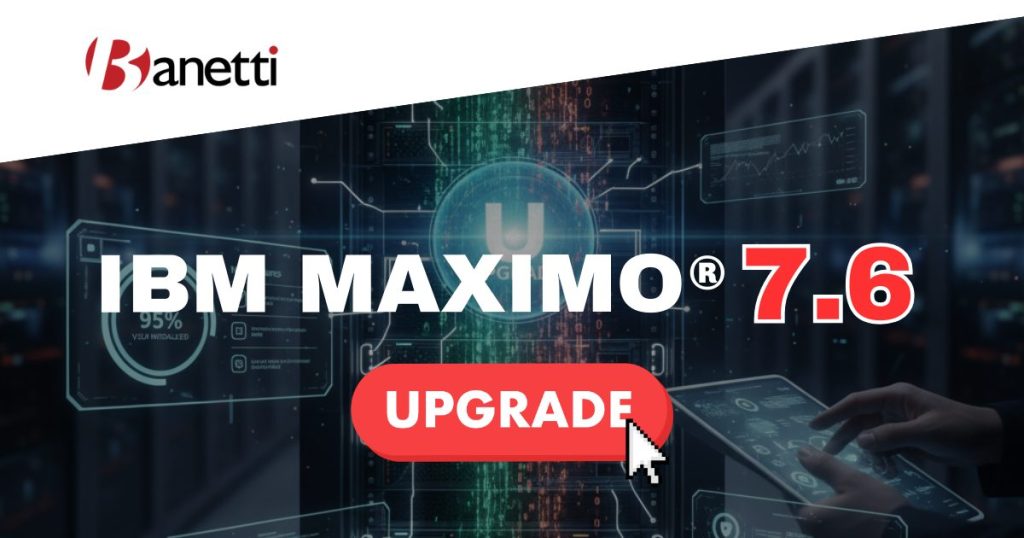5 Min Read
Table of contents

IBM Maximo® 7.6 has been a cornerstone in enterprise asset management (EAM), trusted by organizations worldwide to manage and optimize their assets, workflows, and operations. However, as technology advances, IBM Maximo® is transitioning to a more robust, cloud-native platform, IBM Maximo® Application Suite (MAS). and announcing the end of support for Maximo 7.6.
For businesses using IBM Maximo®, this means an urgent need to plan and execute upgrades to ensure continued performance, security, and system reliability.
This article provides a detailed look at IBM Maximo® 7.6’s end-of-support timeline, the benefits of upgrading to the latest version, and key strategies for organizations to prepare for and execute a seamless transition to MAS.
IBM Maximo®️ 7.6 Support Timeline

As the end of support approaches, it’s important to understand the key dates and deadlines that define how long IBM Maximo® 7.6 will remain viable for your enterprise asset management system.
Official End of Support (EOS)
IBM Maximo® 7.6 officially reached End of Support (EOS) on September 30, 2025. This date marks the cessation of regular support for Maximo 7.6, meaning no more patches, security updates, or critical fixes will be available from IBM Maximo®. Businesses that continue to use this version after the EOS date will risk facing security vulnerabilities, system inefficiencies, and potential compliance issues, as the software will no longer receive vital updates.
For users on IBM Maximo® 7.6.1.x, IBM is offering a grace period with extended support available until September 30, 2026, followed by sustained support until September 30, 2030. While extended and sustained support can offer a temporary safety net, these options come at an added cost and do not deliver new features or functionalities.
Why Support Matters
As the end-of-support deadline approaches, businesses must understand the crucial role of IBM Maximo®’s support in maintaining system performance and data security. Without regular updates, IBM Maximo® 7.6 could become prone to system downtimes, data breaches, and non-compliance with evolving industry regulations. To avoid these risks, businesses must proactively plan their upgrade strategy.
What’s New in IBM Maximo®️ 7.6.1.x

The 7.6.1.x series introduced critical enhancements that extended the life of IBM Maximo® before its eventual retirement, giving businesses more options to manage assets and prepare for transition.
Version 7.6.1.2 Highlights
IBM Maximo® 7.6.1.2 introduced several enhancements to the platform, particularly around user interface improvements, better mobile access, and support for advanced analytics such as Cognos 11. These updates made IBM Maximo® more user-friendly and responsive to the needs of modern asset management, enabling easier navigation and more powerful reporting tools. Additionally, the integration of IoT features and real-time notifications improved decision-making for asset managers.
Version 7.6.1.3 (Final Fix Pack)
IBM Maximo® 7.6.1.3 was released as the final fix pack for this version, offering over 1,100 resolved issues and introducing crucial features such as roll-up maintenance costs and advanced mobile inventory tools. These improvements were designed to enhance operational efficiency and asset tracking, positioning 7.6.1.3 as a stable, robust version for businesses in need of extended support before migrating to IBM Maximo® Application Suite.
Upgrade Path Options

Businesses evaluating their next steps need to decide whether to extend the life of their current system with 7.6.1.3 or embrace the future with IBM Maximo® Application Suite (MAS).
Upgrade to 7.6.1.3
For businesses still running IBM Maximo® 7.6 or 7.6.1.1, the first step toward future-proofing operations is to upgrade to IBM Maximo® 7.6.1.3. This version offers the latest patches and feature updates that extend the functionality and reliability of IBM Maximo®, ensuring a stable platform while organizations plan for the transition to the IBM Maximo® Application Suite.
Upgrade Path to IBM Maximo® Application Suite (MAS)
For those ready to take the leap into the future of asset management, upgrading to IBM Maximo® Application Suite (MAS) offers a path to the latest technology and capabilities. MAS introduces cloud-native architecture powered by Red Hat OpenShift, which provides organizations with scalability, flexibility, and advanced analytics. To transition to MAS, businesses must be on IBM Maximo® 7.6.1.2 or higher. MAS also integrates AppPoints licensing, a flexible model that gives users access to different applications as needed.
This transition to MAS brings new functionality, such as AI-powered predictive maintenance, greater mobile capabilities, and seamless integration with IoT systems. For businesses eager to embrace the next generation of asset management, MAS provides the tools needed for long-term success.
Technical and Strategic Considerations

Shifting from IBM Maximo® 7.6 to MAS is not just a technical upgrade. It requires a strategic rethink of infrastructure, licensing, and integrations to align with the future of asset management.
Infrastructure and Architecture Shifts
One of the most significant changes when migrating from IBM Maximo® 7.6 to MAS is the shift in infrastructure. IBM Maximo® 7.6 is based on a monolithic architecture, while MAS uses a containerized cloud model. This requires organizations to evaluate their current IT infrastructure and ensure they are cloud-ready.
Transitioning to MAS often involves adopting technologies like Red Hat OpenShift, which might require specialized skills and additional resources for implementation.
Licensing Transition (AppPoints)
Along with the architecture shift comes the transition from traditional licensing to the AppPoints model in MAS. This model allows organizations to purchase and manage entitlements based on their specific needs, optimizing costs and usage. However, businesses must carefully evaluate their licensing requirements to avoid overcommitting to unnecessary services or underutilizing critical features.
Customization & Integration Review
For businesses that have heavily customized their IBM Maximo® 7.6 environment, a thorough review is necessary to assess which customizations can be migrated to MAS. Integrations with third-party tools and systems, such as ERP platforms, must also be revisited to ensure compatibility with the new platform. While MAS supports a wide array of integrations, some older configurations may require rework to function seamlessly.
Post-Support Options for IBM Maximo® 7.6

Not every organization can transition immediately, which makes it important to consider the extended and third-party support options available once official IBM Maximo® support ends.
IBM Maximo®️ Extended Support
For those unable to transition immediately, IBM Maximo® offers Extended Support for IBM Maximo® 7.6, which provides critical defect fixes and assistance with urgent issues until September 30, 2026. However, this service comes at an additional cost and is a temporary solution to bridge the gap before migrating to MAS.
Third-Party Support (e.g., Naviam)
Organizations that prefer to delay their upgrade further can consider third-party support options. Companies such as Naviam offer extended support services for IBM Maximo® 7.6, ensuring that businesses continue to receive essential support, including security patches and technical assistance, beyond IBM Maximo®’s official EOS. However, third-party support generally lacks access to the latest features and requires a careful assessment of costs and service levels.
Best Practices for a Smooth Upgrade

To reduce risks and ensure a successful transition, organizations should follow best practices that cover technical preparation, testing, training, and long-term planning.
1. Back Up All Data and Configurations
Before starting any upgrade, it’s critical to back up all IBM Maximo® data, configurations, and customizations. This ensures that organizations can recover quickly in case of unexpected issues during the upgrade process.
2. Review Asset and Workflow Customizations
Take the time to review existing customizations in IBM Maximo® 7.6, including workflows, automation, and user interface elements. Ensure that these customizations are compatible with the new platform, or consider how they can be improved or replaced.
3. Clean Up Unused Applications and Objects
Before migrating, remove any unused applications or custom objects that are no longer needed. This will reduce the complexity of the upgrade and help streamline system performance.
4. Test in a Sandbox Environment
Before going live with the new system, test the upgrade in a sandbox environment. This allows businesses to simulate the upgrade process and address potential issues in a controlled setting without disrupting ongoing operations.
5. Train Users on the Updated Interface
The transition to MAS will involve a new user interface, particularly for mobile users. Ensure that employees are properly trained on the new features and functions of the system to maximize adoption and productivity.
6. Start Planning for MAS
Even if you upgrade to IBM Maximo® 7.6.1.3 as a short-term solution, begin planning for the eventual transition to MAS. The earlier you start preparing for the shift, the easier the migration process will be when the time comes.
Conclusion
The clock is ticking for IBM Maximo® 7.6 users as the end of support approaches. Upgrading to 7.6.1.3 or transitioning to IBM Maximo® Application Suite (MAS) is no longer just an option; it’s a necessity for long-term performance, compliance, and security.
Partnering with the right experts can make all the difference. Banetti, a leading EAM consulting platform, specializes in helping businesses implement IBM Maximo® and maximize its benefits. From guiding upgrade processes to tailoring IBM Maximo® Application Suite to industry solutions, Banetti ensures that your transition is seamless, cost-effective, and future-ready.


